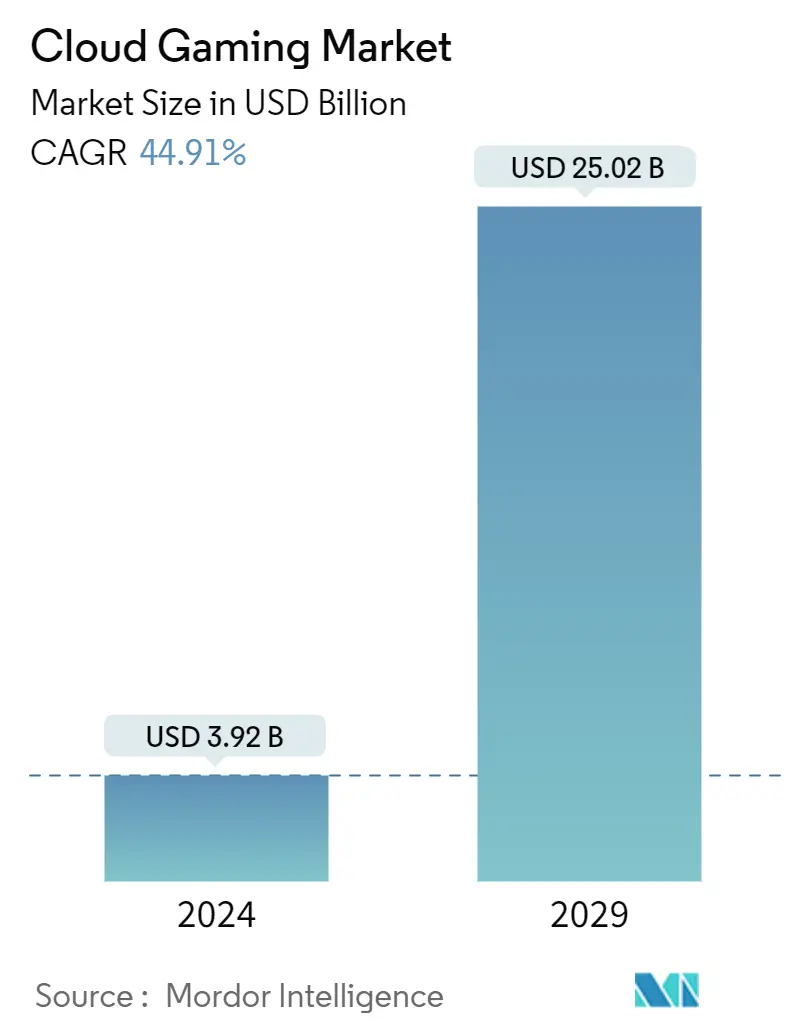Market Size of Cloud Gaming Industry

| Study Period | 2019 - 2029 |
| Market Size (2024) | USD 3.92 Billion |
| Market Size (2029) | USD 25.02 Billion |
| CAGR (2024 - 2029) | 44.91 % |
| Fastest Growing Market | Middle East and Africa |
| Largest Market | Asia Pacific |
Major Players
*Disclaimer: Major Players sorted in no particular order |
Need a report that reflects how COVID-19 has impacted this market and its growth?
Cloud Gaming Market Analysis
The Cloud Gaming Market size is estimated at USD 3.92 billion in 2024, and is expected to reach USD 25.02 billion by 2029, growing at a CAGR of 44.91% during the forecast period (2024-2029).
The market's growth is majorly attributed to technological advancements, such as cloud computing, high-speed internet connectivity, streaming technology, and government initiatives related to cloud infrastructure.
- The recent advancement in advanced cloud technology has turned the idea of cloud gaming into a real scenario. Cloud gaming renders the interactive gaming application remotely in the cloud and then streams the scenes as a video sequence back to the player over the internet. This is the advantage for less-powerful computational devices that are otherwise incapable of running high-quality games.
- The growing number of internet users and the tendency to play games on mobile devices with storage issues in many devices are major drivers for the market. A significant advantage of cloud-based gaming is that games are available anytime from almost any device, such as smartphones and tablets. Also, mobile cloud gaming is a promising paradigm for gaming delivery, as users can play games on any OS or device. In cloud gaming, the vital server (where all the games are stored) does the computation work, including game scene rendering, game logic processing, video encoding, and video streaming.
- Further, the growing product launches and collaborations are analyzed to bolster the market growth rate during the forecast period. For instance, in December 2023, Apple announced it would now allow apps to stream games on its App Store. It means that brands like Microsoft and Nvidia can launch native apps for their cloud gaming services, such as Xbox Cloud Gaming and GeForce Now, on the App Store for iPhone and iPad. The new policy is global.
- A real-time gaming experience is required to adopt cloud gaming services. A high resolution and frame rate should be paired with low latency for a smooth gaming experience that meets gamers' expectations. However, cloud gaming services are held back by current internet technology and struggle to live up to gamers' expectations because developing countries with low bandwidth penetration are poised to avoid the usage of cloud gaming services and instead go with traditional gaming offers offline use.
- The COVID-19 had a positive impact on the cloud gaming market. During the lockdown, demand for cloud-based games grew as they were free to play on any device and did not need more hardware. Companies like Microsoft, Twitch, and Activision have all reached new heights in player investment. The growing smartphone penetration is one of the significant factors that have contributed to the cloud gaming market.
Cloud Gaming Industry Segmentation
Users can engage in video games through cloud gaming by streaming directly from remote servers over the internet, eliminating the need to download or install games on local devices. The market for the study defines the revenues accrued from the sales of various cloud gaming platforms worldwide.
The cloud gaming market is defined based on the revenues generated from the device type being used globally. The analysis draws on market insights from secondary research and primary sources, encompassing key factors that influence growth, including drivers and restraints.
The cloud gaming market is segmented by type (video streaming, file streaming), by device (smartphones, gaming consoles, PC, mobile devices, others), by game type (casual gamers, avid gamers, lifestyle gamers), by geography (North America [United States, Canada], Europe [Germany, United Kingdom, France, Italy, Rest of Europe], Asia-Pacific [China, Japan, India, Rest of Asia-Pacific], Latin America, and Middle East and Africa). The report offers market forecasts and size in value (USD) for all the above segments.
| By Type | |
| Video Streaming | |
| File Streaming |
| By Device | |
| Smartphones | |
| Gaming Consoles | |
| PC | |
| Mobile Devices | |
| Others |
| By Gamer Type | |
| Casual Gamers | |
| Avid Gamers | |
| Lifestyle Gamers |
| By Geography | |||||||
| |||||||
| |||||||
| |||||||
| Latin America | |||||||
| Middle East and Africa |
Cloud Gaming Market Size Summary
The cloud gaming market is poised for significant expansion, driven by advancements in cloud computing, high-speed internet, and streaming technologies. This growth is further supported by government initiatives to enhance cloud infrastructure. Cloud gaming allows users to play high-quality games on less powerful devices by streaming game content from remote servers, making it accessible on smartphones and tablets. The increasing number of internet users and the popularity of mobile gaming, coupled with the ability to play games without the need for extensive storage, are key factors propelling market growth. The COVID-19 pandemic also accelerated adoption as more users sought accessible gaming solutions that did not require additional hardware.
The market is characterized by strategic collaborations and product launches, with major players like Nvidia, Microsoft, and others expanding their offerings. The integration of cloud gaming services with telecom providers' monthly billing plans is enhancing market penetration, particularly in regions with growing smartphone usage and 5G network expansion. In the Middle East and Africa, the market benefits from improved internet infrastructure and government support for cloud computing initiatives. Global vendors are partnering with regional telecom companies to develop the cloud gaming ecosystem, catering to the increasing demand in these regions. The market remains fragmented, with companies focusing on partnerships and acquisitions to strengthen their competitive position and expand their solution offerings.
Cloud Gaming Market Size - Table of Contents
-
1. MARKET INSIGHTS
-
1.1 Market Overview
-
1.2 Industry Value Chain Analysis
-
1.3 Industry Attractiveness - Porter's Five Forces Analysis
-
1.3.1 Bargaining Power of Suppliers
-
1.3.2 Bargaining Power of Buyers
-
1.3.3 Threat of New Entrants
-
1.3.4 Threat of Substitute Products
-
1.3.5 Intensity of Competitive Rivalry
-
-
1.4 Assessment of Impact of COVID-19 on the Market
-
-
2. MARKET SEGMENTATION
-
2.1 By Type
-
2.1.1 Video Streaming
-
2.1.2 File Streaming
-
-
2.2 By Device
-
2.2.1 Smartphones
-
2.2.2 Gaming Consoles
-
2.2.3 PC
-
2.2.4 Mobile Devices
-
2.2.5 Others
-
-
2.3 By Gamer Type
-
2.3.1 Casual Gamers
-
2.3.2 Avid Gamers
-
2.3.3 Lifestyle Gamers
-
-
2.4 By Geography
-
2.4.1 North America
-
2.4.1.1 United States
-
2.4.1.2 Canada
-
-
2.4.2 Europe
-
2.4.2.1 Germany
-
2.4.2.2 United Kingdom
-
2.4.2.3 France
-
2.4.2.4 Italy
-
2.4.2.5 Rest of Europe
-
-
2.4.3 Asia-Pacific
-
2.4.3.1 China
-
2.4.3.2 Japan
-
2.4.3.3 India
-
2.4.3.4 Rest of Asia-Pacific
-
-
2.4.4 Latin America
-
2.4.5 Middle East and Africa
-
-
Cloud Gaming Market Size FAQs
How big is the Cloud Gaming Market?
The Cloud Gaming Market size is expected to reach USD 3.92 billion in 2024 and grow at a CAGR of 44.91% to reach USD 25.02 billion by 2029.
What is the current Cloud Gaming Market size?
In 2024, the Cloud Gaming Market size is expected to reach USD 3.92 billion.

